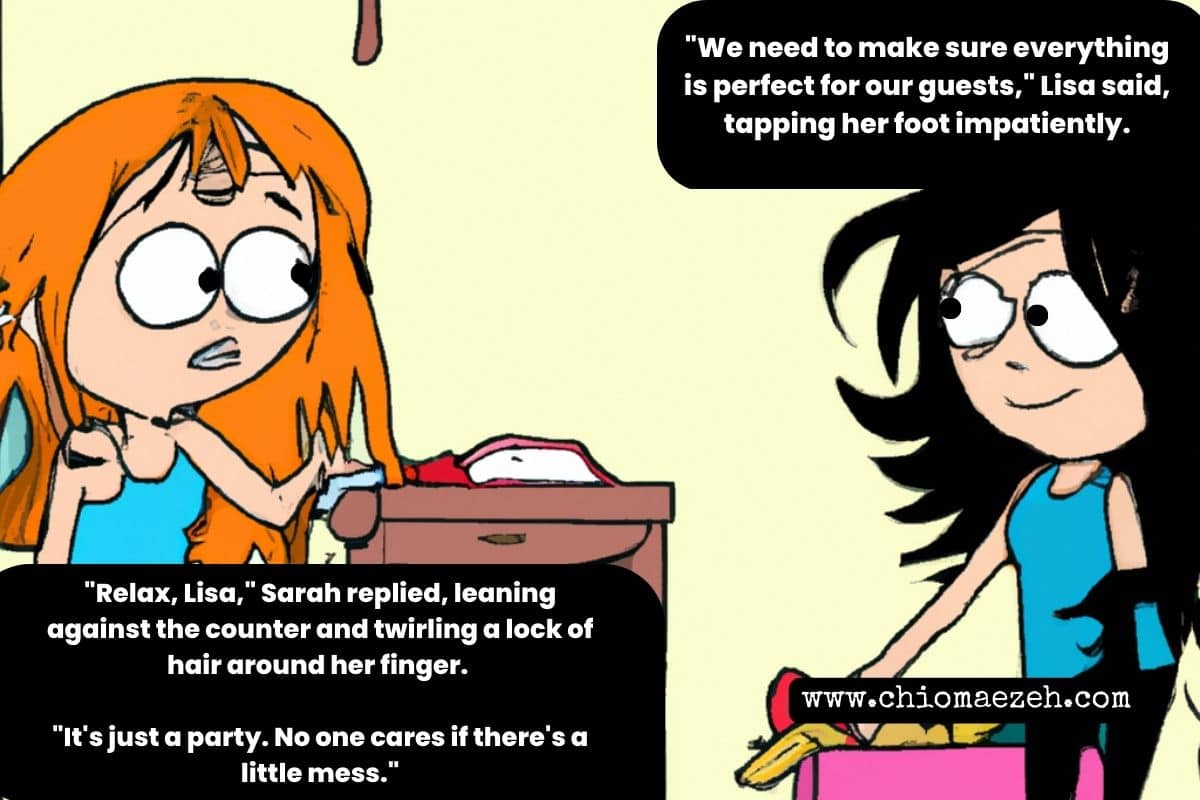How to Write Dialogue Between Two Characters in a Story
Crafting a realistic and engaging dialogue between two people can be challenging for both novice and experienced writers.
While conversations between two people can often derail into chit-chat that may serve no real purpose, dialogue between two characters should serve a purpose. It should breathe life into the characters, reveal their personalities and motivations, and move the plot forward.
In this article, I’ll provide a step-by-step guide on how to write dialogue between two characters in a story.
👉 See our overview guide to dialogue writing for authors
Let’s Talk
Are you a writer aspiring to pen a masterpiece that never fails to captivate? Look no further. Reach out to us and uncover how we can help you to take your writing to unprecedented heights!

What Are The Rules of Writing Dialogue Between Two Characters?
Here are some fundamental rules to follow when writing dialogue between two characters:
- Use quotation marks to indicate spoken words.
- Start a new paragraph each time a different character speaks.
- Keep each character’s voice distinct and consistent throughout the story.
- Avoid lengthy speeches or monologues; strive for a natural back-and-forth exchange.
- Use contractions and informal language to make the dialogue sound more authentic.
- Show, don’t tell; use action beats, body language, and subtext to convey emotions and tone.
👉 For deeper insight, read our guide to the rules of dialogue writing
How to Write Dialogue Between Two Characters in a Story
Step 1: Know Your Characters
Before you can start writing dialogue between two characters, you need to know your characters and learn how the dialogue will affect them in the story. Create a detailed character avatar for each person in your story. Consider their background, personality, goals, fears, and quirks.
When you have a solid understanding of your characters’ traits, you can easily craft authentic dialogue that reflects their unique voices.
For example, imagine you’re writing a story about two roommates, Lisa and Sarah. Lisa is a neat freak who likes everything organized and tidy, while Sarah is more laid-back and messy.

When they’re discussing plans for a party they’re hosting, this kind of dialogue might ensue between them:
Lisa: “We need to make sure everything is perfect for our guests. Can you clean up your side of the room, Sarah?”
Sarah: “Relax, Lisa. It’s just a party. No one cares if there’s a little mess.”
👉 See our guide on how dialogue affects the character in a story
Step 2: Determine the Purpose of the Dialogue
Dialogue should always serve a purpose in your story. Whether it is to reveal information about the characters, advance the plot, or build tension. Before you start writing, determine the specific purpose of the dialogue and what you want to achieve through it.
For example, in the Lisa and Sarah story, the purpose of their dialogue might be:
- to establish their different personality types
- to create conflict around cleanliness.
- to advance the plot by way of revealing their plans for the party and any potential problems or conflicts that may arise.
👉 Click to learn more about the purpose of dialogue in a story
Step 3: Set the Scene (stage)
When you’re writing dialogue between two characters, you need to provide context for the conversation. Set the scene and setting by describing the location, time, and any relevant details that might impact the dialogue.
For example, if Lisa and Sarah are discussing the party while cleaning up their apartment, you might write something like,
“Lisa and Sarah stood in their cramped living room, surrounded by stacks of books, empty takeout containers, and piles of clothes. It was Saturday afternoon, and they were frantically cleaning up before their guests arrived.”
Step 4: Use Dialogue Tags
Dialogue tags are words or phrases that identify who is speaking in the conversation. They’re essential for clarifying the speaker and creating a smooth flow of dialogue.
The most common dialogue tags are “he said” or “she said,” but you can also use other verbs such as “whispered,” “shouted,” “muttered,” or “exclaimed.”
However, you should use dialogue tags sparingly and only when necessary to avoid repetition or interrupting the flow of conversation.

With the Lisa and Sarah story, you may use dialogue tags like this:
“We need to make sure everything is perfect for our guests,” Lisa said. “Can you clean up your side of the room, Sarah?”
“Relax, Lisa,” Sarah replied. “It’s just a party. No one cares if there’s a little mess.”
Step 5: Add Body Language and Action
Dialogue isn’t just about words. Adding body language and action can enhance the conversation and reveal more about the characters’ emotions and intentions. Consider including gestures, facial expressions, and movement to make the dialogue more dynamic.

For example, the Lisa and Sarah story:
“We need to make sure everything is perfect for our guests,” Lisa said, tapping her foot impatiently.
“Relax, Lisa,” Sarah replied, leaning against the counter and twirling a lock of hair around her finger. “It’s just a party. No one cares if there’s a little mess.”
Adding body language and action gives readers a better sense of each character’s personality, mood and atmosphere. It also reinforces the conflict between them.
Lisa’s impatience and Sarah’s casual attitude are evident in their physical movements, which make the dialogue more engaging.
Step 6: Use Subtext
Subtext is the subtle or unspoken meaning or intention behind a character’s words. It’s a powerful tool for creating tension and conflict in dialogue. You can use subtext to create a sense of mystery and intrigue.

For example:
“We need to make sure everything is perfect for our guests,” Lisa said, her voice tight with anxiety.
“Relax, Lisa,” Sarah replied, with a sly smile. “It’s just a party. No one cares if there’s a little mess.”
In this example, Sarah’s sly smile and casual tone suggest that she knows something Lisa doesn’t. This can create tension and intrigue as the plot advances.
Step 7: Keep it Realistic
While dialogue can be a powerful tool for storytelling, you should try to keep it realistic. People don’t always speak in complete sentences, and they often interrupt each other, trail off, or use slang and colloquialisms. Make sure your dialogue sounds natural and reflects the way people actually speak.

For example:
“We need to make sure everything is perfect for our guests,” Lisa said.
“Relax, Lisa,” Sarah replied. “It’s just a party. No one cares if– “
“Yeah, but what if someone spills something on the couch?” Lisa asked.
“Don’t worry about it,” Sarah said, rolling her eyes. “We can always cover it up with a throw pillow.”
In this example, we can see the hyp0hen used indicating an interruption. The dialogue sounds natural and reflects the way people might actually speak in a casual conversation.
To make dialogue feel more authentic, incorporate slangs, colloquialisms, and dialects, but these of course, would depend on your characters’ personality and backgrounds.
Step 8: Edit and Revise
Once you’ve written your dialogue, it’s essential to edit and revise it. Read the dialogue several times. Search for any awkward phrasing, repetition, or inconsistencies. You can also read the dialogue out loud to see how it sounds and identify any areas that need improvement.
Remember that writing is a process, and you may need to revise your dialogue several times to get it right. Don’t be afraid to make changes or try different approaches until satisfied.
A Simple Template: How To Write Dialogue Between Two Characters
Here is a template for writing dialogue between two characters in a story. A well-crafted dialogue can bring your story to life and create memorable interactions between your characters.
Use this simple template to help you write engaging and authentic dialogue between two characters in your story:
- Introduce the Characters
- [Briefly introduce your characters]
- You can include their names and relevant background information that may impact the conversation.]
- Example:
- Characters: Anne and Ben
- Relevant background: College classmates.
- Create Setting and Context
- [Describe the setting of the conversation, including the location and any pertinent details that could influence the dialogue.]
- [Provide context for the conversation, such as the characters’ relationship or the events leading up to the discussion.]
- Example:
- Setting: Library
- Context: Studying for an upcoming exam
- Determine Character Goals or Motivations
- [Identify each character’s goal or motivation for engaging in the conversation.]
- Example:
- Anne’s goal: Focus on studying
- Ben’s goal: Ask Anne on a date
- Define the Conversation Starter
- [Begin the dialogue with an opening line or question that establishes the tone and direction of the conversation.] OR
- [Begin the dialogue with a reaction to something that just happened]
- Example:
- Anne: “I can’t believe we have a test on Friday.”
- Create Dialogue Exchanges
- [Write back-and-forth exchanges between the characters. Make sure each character’s voice remains distinct and consistent.]
- [Use contractions, informal language, and realistic speech patterns to create authentic-sounding dialogue.]
- Example:
- Anne: “I can’t believe we have a test on Friday.”
- Ben: “Yeah, it’s going to be tough. But, hey, are you free tonight?”
- Use Action Beats and Body Language
- [Incorporate action beats and body language to convey emotion, tone, and mood.]
- [Use cues to show, rather than tell, how a character is feeling or what they are thinking.]
- Example:
- Anne (furrowing her brow): “I really need to focus on studying, Ben.”
- Ben (scratching the back of his neck): “Oh, right, of course. I was just wondering if you wanted to grab dinner later.”
- Advance the Conversation
- [Develop the conversation by revealing new information, creating conflict, or making decisions that move the story forward.]
- Example:
- Anne: “I appreciate the invite, but I’m going to be holed up in here all night.”
- Ben: “No problem. Maybe we could take a study break together?”
- Resolution or Transition
- [Conclude the dialogue with a resolution to the conflict or a transition to the next scene or story development.]
- Example:
- Anne (smiling): “Alright, a short break wouldn’t hurt. Meet back here at 7?”
- Ben (grinning): “Deal. See you then!”
Video Recommendation: How To write dialogue between two characters in a story
For a visual demonstration of writing dialogue between two characters, check out this insightful video:
FAQs on How to Write Dialogue Between Two Characters in a Story
How can I make my dialogue more engaging?
To make your dialogue more engaging:
- Incorporate conflict and tension between characters.
- Use subtext to convey deeper meaning or emotions.
- Balance dialogue with action beats and body language.
- Vary the pacing and rhythm of the conversation.
How can I ensure that each character’s voice remains distinct?
To maintain distinct character voices:
- Develop a unique speaking style, vocabulary, and sentence structure for each character.
- Consistently apply these elements throughout the story.
- Periodically review and revise your dialogue to ensure consistency.
Should I use dialect or accents in my dialogue?
While dialects or accents can add authenticity and depth to your characters, they can also be challenging to write and read. If you use dialects or accents, do so sparingly and focus on capturing the essence of the character’s speech without resorting to heavy phonetic spellings.
Final Notes: How To write dialogue between two characters in a story
Writing engaging and authentic dialogue between two characters is a crucial aspect of fiction writing. By understanding the purpose of dialogue, following essential rules, using a template, and considering other important factors, you can create conversations that resonate with readers and bring your characters to life.

![What Are Action Beats in Writing? [Definition + Examples]](https://chiomaezeh.com/wp-content/uploads/2023/04/what-is-an-action-beat-768x512.jpg)



![What Is Third Person Point of View? [Definition & Examples]](https://chiomaezeh.com/wp-content/uploads/2023/03/third-person-point-of-view-1-768x512.jpg)
![What Is The Three Act Structure? [Defintion, Outline, & Examples]](https://chiomaezeh.com/wp-content/uploads/2023/03/Three-act-structure-1-768x512.jpg)